Ready-to-wear clothing has truly revolutionized the fashion industry. It's remarkable how standardized sizing and mass production have made fashionable attire accessible to everyone, not just the elite. What was once a luxury is now a staple that we can find in department stores and catalogs. This shift has democratized fashion, allowing us all to curate our wardrobes without waiting for custom-made fits. Ready-to-wear garments capture the essence of modern consumer culture – quick, varied, and inclusive. Thinking about where this all started and what it means today makes me realize there's so much more to explore about its far-reaching impact.
What Is Ready-To-Wear?
Ready-to-wear clothing, unlike custom-made garments, is manufactured in large quantities to fit a range of body types. It's fascinating how fashion design has evolved to embrace this concept. The standardization of sizing means you can walk into a store and find something that fits without waiting for a tailor. This shift to ready-to-wear has made fashion accessible, no longer just for the elite.
Mass production has made this possible. Factories churn out clothes in bulk, ensuring there's always something on the racks. This approach democratizes fashion, making it more affordable and inclusive. When you think about it, it's not just about clothing; it's a statement about accessibility and innovation.
The beauty of ready-to-wear lies in its immediacy. There's no need for endless fittings or long waits. You find your size, make a choice, and walk out with a piece of fashion design that's ready to wear. It's an efficient system that still captures the essence of personal style. That's the true appeal of ready-to-wear.
Historical Background
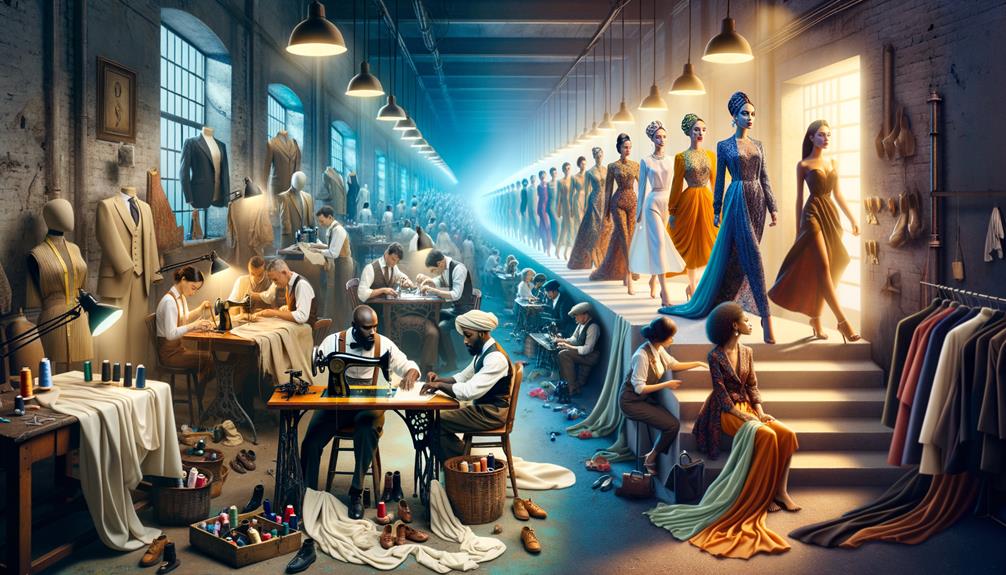
When I think about how clothing production shifted from handmade to machine-made, it's clear that early industrialization paved the way for mass production. This change didn't just improve efficiency – it made fashion accessible to more people. The democratization of clothing was a pivotal moment, transforming how we dress and express ourselves.
The rise of factories and mass manufacturing allowed clothes to reach a wider audience. No longer was fashion limited to the elite; the average person could now afford stylish garments. This accessibility gave people more freedom to experiment with their personal style and showcase their individuality through their wardrobe choices.
The transition from handmade to machine-made clothing revolutionized the industry. It increased output, reduced costs, and ushered in new design possibilities. Trends could spread faster, and people could stay up-to-date with the latest fashions. This cultural shift empowered individuals to use clothing as a means of self-expression, rather than just functionality.
Early Industrialization Impact
The fashion industry underwent a significant transformation during the Industrial Revolution. Ready-to-wear clothing emerged to cater to changing lifestyles and growing consumer demands. Advancements in textile technology, such as synthetic fibers and improved fabric dyeing, enabled large-scale, cost-effective production of garments. These innovations revolutionized the industry, making clothing more accessible and affordable than ever before.
The invention of sewing machines and the adoption of assembly line production methods streamlined manufacturing processes. This technological shift also had cultural implications, as fashion became more democratized and reached a wider audience. The establishment of department stores in the late 19th century played a crucial role in this dissemination, offering ready-to-wear collections to an expanding customer base.
Fashion designers, particularly from Parisian haute couture houses, began to embrace this change by introducing ready-to-wear lines, making high fashion more accessible to the masses. This period marked a substantial departure from the bespoke tailoring of the past, setting the stage for an inclusive fashion industry that catered to the needs of a rapidly evolving society. The Industrial Revolution didn't just change how we produced clothing; it changed the very meaning of fashion.
Mass Production Emergence
The mass production of clothing completely transformed the fashion industry in the early 19th century. The sewing machine, a groundbreaking technology of its time, brought newfound efficiency and precision to textile manufacturing. Suddenly, garments were no longer painstakingly handmade, but swiftly assembled, marking the dawn of ready-to-wear clothing. This shift wasn't just about speed; it signalled a world of new possibilities.
Standardized sizing and graded patterns in the mid-1800s further fueled this revolution. Consistency became a hallmark, making it feasible to produce clothing in large quantities. Ready-to-wear wasn't just a convenience; it was a symbol of progress, meeting the needs of an increasingly urbanized world.
As cities grew and populations expanded, the demand for accessible fashion skyrocketed. The rise of ready-to-wear responded to this demand, offering affordable options to the masses. Mail-order catalogs, emerging in the late 19th century, expanded the reach even further, bringing stylish attire to remote areas.
Department stores also played a crucial role, becoming hubs of fashion where ready-to-wear garments were displayed and desired. The textile industry, powered by innovation, was forever transformed. This was more than just a trend; it was a revolution that reshaped the industry.
Clothing Democratization Shift
Fashion became accessible to everyone as ready-to-wear clothing transformed from a luxury reserved for the elite to an everyday staple. The late 19th century marked a pivotal shift. What once required custom tailoring could now be quickly produced and sold in burgeoning department stores. It was a time when urbanization demanded convenience and affordability, reshaping how we viewed clothing.
I've always been fascinated by how the democratization of fashion mirrored societal changes. Ready-to-wear (RTW) clothing wasn't just about garments; it represented a new era of accessibility. Advances in clothing manufacturing, from textile technology to sewing machines, made it possible. Suddenly, fashion wasn't confined to the wealthy. It was for the clerk, the teacher, and the factory worker.
Department stores played a vital role. They were more than just retail spaces; they were symbols of modernity, offering a variety of styles under one roof. Influential couture houses like Chanel and Dior saw the potential, inspiring RTW collections that brought high fashion to the masses.
This shift didn't just alter wardrobes. It changed identities, allowing individuals to express themselves affordably and easily. Fashion had truly become a force that empowered the average person.
Key Differences: Ready-To-Wear Vs Made-To-Measure
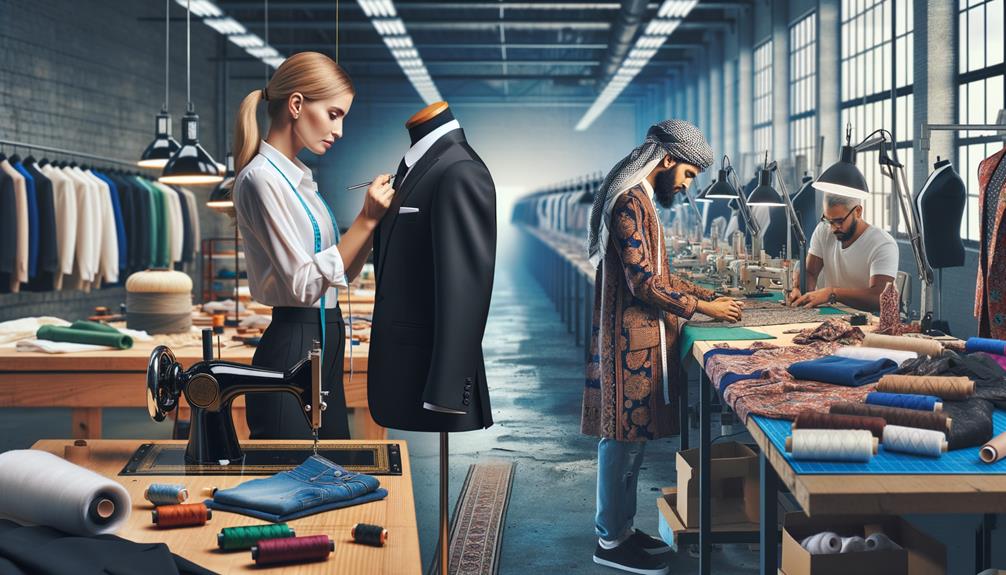
When it comes to off-the-rack versus custom-made clothing, the differences in production and pricing are quite stark. Ready-to-wear garments are generally quick and affordable, while custom-made pieces require waiting weeks and come at a higher cost. However, each option offers unique advantages – ready-to-wear provides easy accessibility, while custom-made ensures a perfect fit.
The process of creating ready-to-wear clothing is relatively straightforward. Manufacturers produce pieces in standard sizes, allowing them to be mass-produced efficiently and sold at lower prices. This makes them widely available and accessible to the average consumer.
On the other hand, custom-made or bespoke clothing is tailored specifically to the individual's measurements and preferences. This level of personalization takes time, as the garment is meticulously crafted to achieve the perfect fit. As a result, custom-made pieces often carry a higher price tag than their off-the-rack counterparts.
The choice between ready-to-wear and custom-made ultimately comes down to individual needs and preferences. Those seeking immediate gratification and a more budget-friendly option may opt for ready-to-wear, while those who value a flawless fit and are willing to invest more time and money may prefer the custom-made route.
Production Process Differences
In considering production processes, the contrast between ready-to-wear and made-to-measure clothing is quite revealing. The fashion industry has seen a significant shift with the advent of ready-to-wear garments. These mass-produced pieces in standard sizes offer immediate availability, a defining feature of modern consumer culture. This approach allows for widespread distribution and rapid turnover, catering to the fast-paced demands of contemporary fashion.
On the other hand, made-to-measure garments reflect a slower, more meticulous production process. Custom-tailored to individual measurements, these pieces require an 8-10 week timeframe for production and delivery. The result is a personalized fit that ready-to-wear simply can't match without alterations. Limited production runs in made-to-measure guarantee not just high quality, but also a unique touch, making each garment distinct.
The ready-to-wear model relies on the reputation of brands to assure quality, although the need for alterations is common. Made-to-measure, however, offers a higher degree of trust and customization from the outset, setting a different standard of sartorial satisfaction. The production process differences are stark, each catering to diverse consumer needs and desires.
Pricing and Affordability
When it comes to ready-to-wear versus made-to-measure, the differences in pricing and affordability are quite striking. Having navigated both spaces, I've noticed a substantial cost disparity. Ready-to-wear collections are generally more accessible, with jackets starting around £595. On the other hand, made-to-measure suits, with their bespoke appeal, typically begin at £1,295.
Here are a few key points to consider:
- Immediate Availability: Ready-to-wear garments can be purchased right away, eliminating the 8-10 week wait common with made-to-measure orders.
- Cost Efficiency: While ready-to-wear may compromise slightly on quality, high-end brands ensure unique, limited production runs, balancing affordability with exclusivity.
- Customization Options: Ready-to-wear can be altered for a personalized fit, but it can't match the fully customized experience of made-to-measure.
The 20th century saw a shift towards mass production, making fashion more democratized. Yet, innovation in ready-to-wear has kept quality and exclusivity within reach. It's fascinating how ready-to-wear, despite its lower price point, continues to evolve, meeting the demands of a market that craves both immediacy and individuality. For those seeking innovation without the hefty price tag, ready-to-wear remains a compelling choice.
Tailoring Techniques
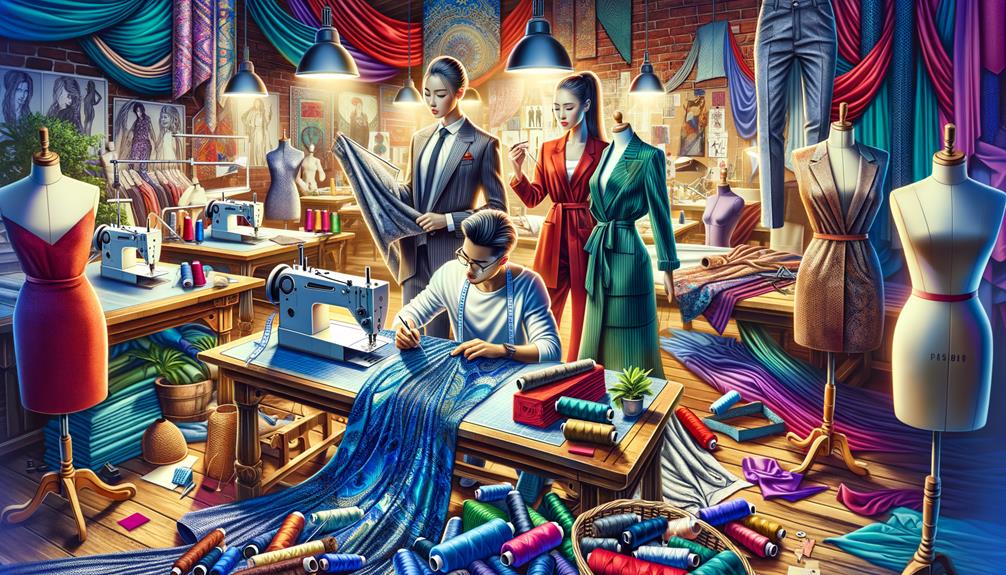
Tailoring techniques transform off-the-rack clothing into garments that feel uniquely our own. When I slip into ready-to-wear pieces, they're more than just standard items. Adjusting lengths, waists, and sleeves makes a real difference. It's not just about fit; it's about feeling like these clothes were made just for me.
Some retailers offer complimentary alterations for full-price trousers. This service ensures a standard pair of pants can match my exact measurements. Similarly, off-the-rack shirts can be tailored to achieve the perfect fit, bridging the gap between ready-to-wear and more personalized options like custom clothing.
Jackets and blazers from ready-to-wear lines often come in limited quantities and high-quality fabrics. When tailored, they offer a sense of exclusivity that's hard to find elsewhere. These pieces, once adjusted, feel like a second skin.
In a world that values individuality, tailoring elevates ready-to-wear clothing, making each garment feel bespoke. It's fascinating how small changes can transform the way we experience fashion, making it both personal and innovative.
Textile Choices
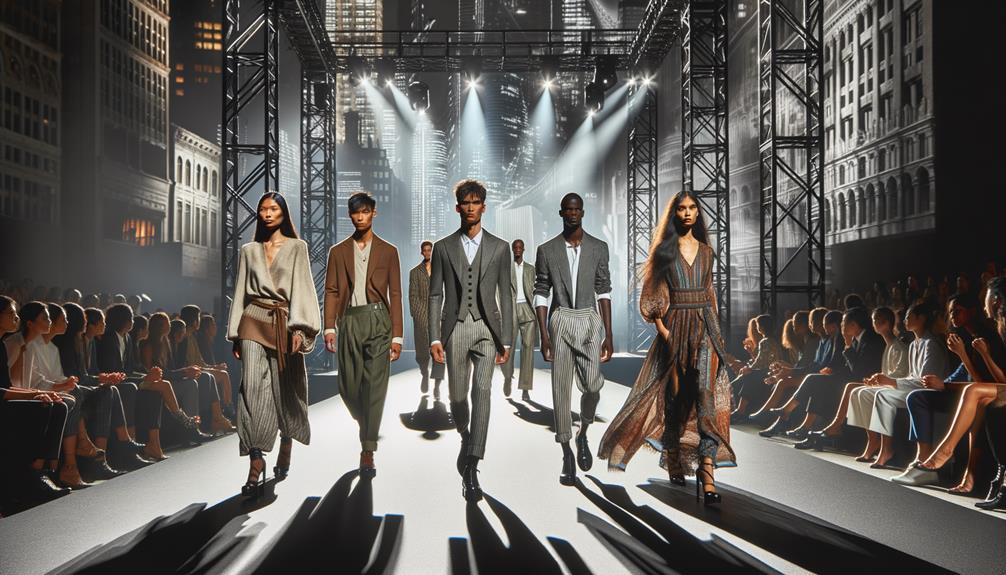
Every fabric tells a story, and the clothing we wear captures this essence with each unique textile choice. Looking back at the advancements in textile and dyeing processes since the late 19th and early 20th centuries, it's clear that we've built upon the innovations of the past. Today, the vibrant, premium textiles sourced from mills in the UK and Italy define fashion.
By maintaining these textiles every season and producing garments in limited quantities, designers ensure that exclusivity and quality remain at the forefront. Here's how these textile choices shape the fashion landscape:
- Premium Quality: The use of high-quality fabrics speaks to the craftsmanship and attention to detail synonymous with fashion.
- Seasonal Refresh: Limited production runs mean that textiles are constantly evolving, offering fresh options each season.
- Personalization: Customers can inquire about different cloth options for made-to-measure services, adding a personal touch to their wardrobe.
Observing these practices, it's clear that each fabric embodies a narrative of innovation and exclusivity. Fashion isn't just about clothing—it's about celebrating the artistry embedded in every thread.
Future Trends
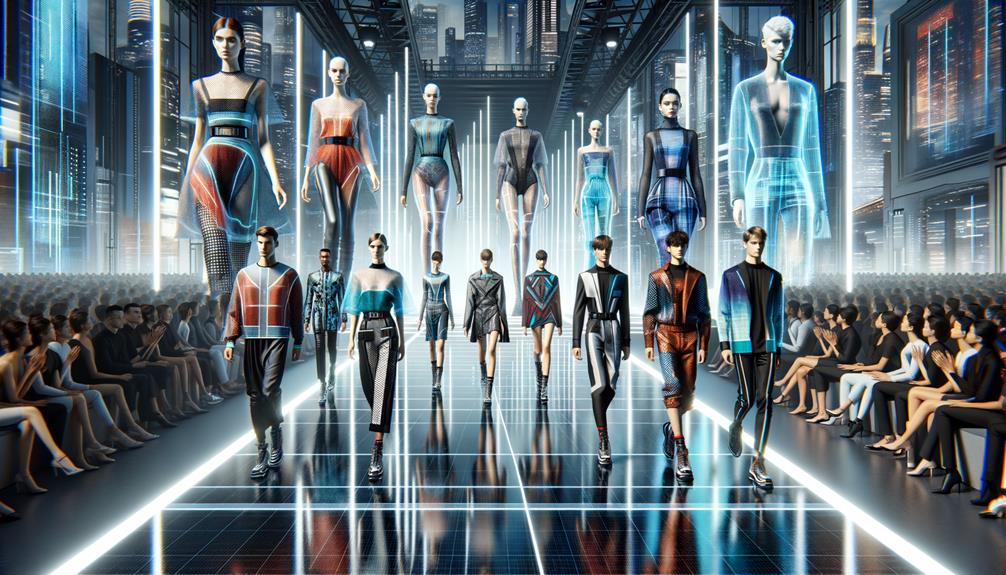
As we look ahead, the future of ready-to-wear clothing will blend tradition with cutting-edge technology, reshaping how we experience fashion. Yves Saint Laurent once revolutionized fashion by making high style accessible. Now, the rise of smart and connected clothing is doing the same, allowing individuals to personalize their wardrobe and track garment usage.
Digital fashion is on the cusp of redefining how consumers engage with fashion. Virtual try-ons and digital-only garments offer a wide range of possibilities, reducing the need for physical products and thereby lessening environmental impacts. This shift could mark the start of a new era in fashion trends, where sustainability and technology work together.
Innovative design tools powered by AI are set to optimize supply chains, ensuring production aligns better with consumer demand. This means less waste and more thoughtful consumption. Additionally, circular economy models like rental, resale, and repair services are gaining popularity, challenging traditional ready-to-wear business models and prioritizing sustainability.
Inclusivity and body positivity are no longer just buzzwords. The industry is expanding size ranges and offering customizable fits, making it possible for everyone to find something that suits them. The future of fashion is not just about what we wear, but how and why we wear it.
Frequently Asked Questions
What Are the Benefits of Ready-To-Wear Fashion?
Ready-to-wear fashion offers several advantages. It's convenient – I don't have to wait for items to be custom-made, and I can easily find pieces that fit my style and budget. The wide variety of styles available means I can discover new looks that suit me. Plus, I can often tailor ready-to-wear items for a perfect fit, so I don't have to compromise on how garments look and feel. Overall, the immediate availability and flexibility of ready-to-wear fashion make it a practical and appealing option for my wardrobe.
What Is Ready-To-Wear in the Fashion Industry?
Ready-to-wear fashion refers to mass-produced clothing that is designed to fit a wide range of body types. It arose from industrialization, making stylish garments accessible and available to the general public, rather than just the elite. This has democratized fashion, allowing more people to express their personal style.
The key aspects of ready-to-wear are its standardized sizing, quick production, and diverse offerings. Consumers can easily find and purchase fashionable pieces that suit their needs and preferences. This contrasts with custom-made garments, which are tailored to individual measurements.
Ready-to-wear has revolutionized the fashion industry, transforming it from an exclusive luxury to a mainstream phenomenon. By catering to the masses, it has empowered people to experiment with different styles and trends, fostering greater self-expression through clothing.
When Did Ready-To-Wear Clothing Become Popular?
Ready-to-wear clothing gained widespread popularity in the late 19th and early 20th centuries. Advancements in manufacturing and the growth of urban centers made fashionable garments more accessible to the general public. This shift transformed the fashion industry, introducing greater innovation and diversity.
Department stores of the 1900s were hubs of this emerging ready-to-wear trend. Industrialization allowed for mass production, while urbanization created a larger customer base eager for the latest styles. As a result, fashion became more affordable and available to the average person, rather than solely the wealthy elite.
This period marked a significant transition in how people acquired and consumed clothing. Ready-to-wear offerings provided an alternative to custom-made garments, catering to the needs of a rapidly changing society. The rise of this approach paved the way for the diverse and ever-evolving fashion landscape we know today.
What Are the Reasons for the Popularity of Readymade Garments?
Readymade garments became popular due to their convenience, affordability, and variety. They saved people time, fit many body types, and were widely available in department stores. Advancements in manufacturing made them cheaper, appealing to an increasingly urban population. The ready-to-wear clothing trend offered a practical solution as lifestyles became busier and more fast-paced. People could quickly find stylish options that fit their needs without the hassle of custom tailoring. The diverse selection also allowed individuals to express their personal style more easily. Overall, the rise of readymade garments catered to the evolving needs and preferences of consumers in a changing society.
Conclusion
Ready-to-wear clothing has revolutionized the fashion industry. It's like a tree in an urban landscape – rooted in tradition yet constantly evolving. This bridge between the past and the future is where classic styles meet innovative designs. As I witness this fashion transformation, each stitch feels like a step forward, and every fabric choice a new chapter in an ever-changing story. The horizon is brimming with possibilities, and I can't help but feel we're on the cusp of something truly remarkable. The future of fashion is not just about what we wear, but how we live.



